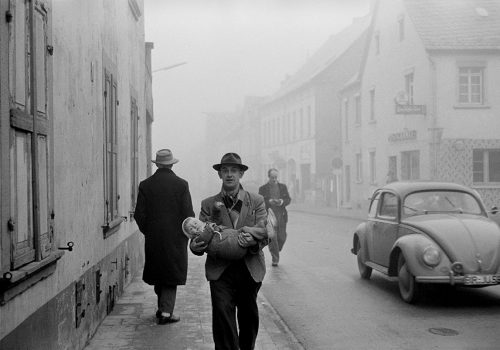In 1959, a young man of twenty-six captured a group of children in a Cologne street, a very powerful photographic composition. It’s probably summer; we feel the heat. Everything is there, everything that makes cubism, poetry, the modernity of what a real image is. We are almost in the same atmosphere as the photographs of Helen Levitt in New York. A year earlier, publisher Robert Delpire published one of the key books in the history of photography: The Americans, by Robert Frank, an iconic book of the power of photographic language. Five years later, in 1963, this same publisher published a second book just as essential: Les Allemands, by René Burri; we can never thank him enough.
But what makes the Americans – admittedly an absolute masterpiece – constantly cited, while the Germans are rarely mentioned? In fact, as soon as we talk about the United States – a country hated by so many people in Europe for no reason -, the interest manifests itself immediately: whether in literature through Jack Kerouac for example, while Nicolas Bouvier is less known and yet of the same importance; in cinema with Graine de violence by Richard Brooks (1955) while The Loneliness of long distance runner by Briton Tony Richardson is the very film of rebellion; also in photography where photography schools systematically mention The Americans, often omitting The Germans, which is, no doubt, of equal importance. Also, this admirable book will be unfairly appreciated only by some connoisseurs of photography … Germany is a subject so much more ungrateful and difficult – we are ten years from the end of the Second World War – than the result is all the more commendable! Indeed, who is interested in the life of the Germans in the early 1960s? Person ! The subject is almost taboo, even in Europe. While everyone is passionate about the “American Way of Life”, its roads, its cities, its lifestyles, its customs, its women. But, these themes are also in The Germans because, this style of “free” photography, I would say, was historically born in the United States with Ben Shahn in the 1930s – a friend of Walker Evans – and in Europe with Moholy Nagy for example.
By leafing through The Germans by René Burri, one is literally struck by the force of the images and full of admiration for the book itself. It is not the result of some good photographs, but of a whole set constructed from page to page, from image to image: a street with few people; a little girl running next to a side-parked Messerschmitt, a rare car at the time; in West Berlin, in 1959, on a sunny day, a man who could be Khrushchev is from behind in front of modern reconstructed buildings, on his right a guy sells bananas, on his left some figures; in Frankfurt, people in the street opposite and, behind, on the left, a woman passes, on the right, a man stands out – they are all in the right place (Henri Cartier-Bresson? …). I could repeat these descriptions page after page. Nothing important is going on there; but precisely a large photograph is not necessarily something “important”, but usually trivial. Knowing how to see this is not as easy as it seems! The Germans also offer us this remarkable series of vertical photos: in Bonn, in 1962, a little girl with very “Frankian” flowers; Frankfurt train station, the man in the cap; the Mercedes in the foreground, a young woman passing by and a sign on the left – very dynamic composition -; in Hamburg, in 1962, in a cafe, a couple of lovers under a clock. And who is this woman who crosses the picture, in front of officials and flags, Place Marx-Engels in West Berlin, in 1959? What is she doing there? It’s an unanswered photographic moment, but one of the most beautiful! Without forgetting the group of men, in Essen, in 1960, with such a serious pose almost reminiscent of the characters in the photographs of Erich Salomon.
Aside from this last image, the photographs I have just mentioned are not the best known in the book, but they are the ones that haunt me, the ones that have marked my memory forever! And I can’t say enough thank you to René Burri for his magnificent work and especially for The Germans: I’m crazy about it – and Agnes de Gouvion Saint-Cyr would not say the opposite! René Burri is one of those who have forever opened new doors to the photographic language, just like Aldous Huxley with his book Les Portes de la perception (1954). Undoubtedly, René Burri is one of the most important and one of the most modern authors of the second half of the 20th century.
Bernard Plossu
Excerpt from the text by Bernard Plossu, “On the book Les Allemands de René Burri”.
Appeared in the René Burri catalog, L’explosion du regard, Editions Noir sur blanc, Collection Musée de l’Elysée and Scheidegger & Spiess, February 2020.
René Burri : Les Allemands
March 4 – April 18, 2020
Galerie Folia
13 Rue de l’Abbaye, 75006 Paris, France
















